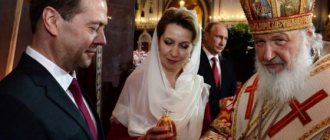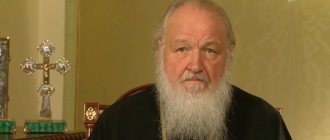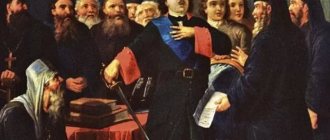Ecumenical Patriarch Kirill
In the days when the Russian Church celebrates the 73rd anniversary and the half-century anniversary of the service in the priesthood of its Primate, the Orthodox world is again faced with a question that was already raised at the very beginning of the life path of His Holiness Patriarch Kirill
There is a high probability that today, the 73rd birthday of the Primate of the Russian Orthodox Church, His Holiness Patriarch Kirill, will be celebrated as the birthday of the Patriarch of Moscow and All Rus'... for the last time. The whole logic of modern church history leads to the fact that very soon the Russian First Hierarch will become Ecumenical. Contrary to their own will and the will of their predecessors, who had long been worthy of this title of “first among equals” of the hierarchs of the Church of Christ, but for more than half a millennium, in a truly Christian manner, they humbly humbled themselves before the four ancient Eastern Patriarchs.
Church of the Third Rome
Starting from the middle of the 15th century, when the Russian Church acquired autocephaly, it could repeatedly become the first in the diptych of Orthodox Local Churches. Not for the sake of earthly glory and greatness, but by the fact of its position: as the Church of the only independent Orthodox state - the Kingdom of Moscow, the young Christian Empire, which became the heir to the Kingdom of the Romans (Byzantium) that fell in 1453. Moreover, the only one of the Local Churches that clearly and unequivocally spoke out against the betrayal of Orthodoxy committed by the Greek hierarchs who signed the Union of Florence in 1439 and thereby found themselves under the authority of the popes for several decades.
Subsequently, the Russian Church had other historical opportunities to receive Ecumenical status. This was the case, for example, in 1588, when the Patriarch of Constantinople Jeremiah II arrived from Constantinople captured by the Turks to New Constantinople - the Third Rome - and actually proposed to the Russian Tsar Theodore Ioannovich to make Moscow the city of the Ecumenical Patriarchs. But the Tsar was very different in character from his formidable father, he was humble and meek, and therefore did not dare to take such a fateful action for Orthodoxy.
Patriarch of Constantinople Jeremiah II. Photo: pravoslavie.ru
Then, at the end of the 16th century, Tsar Theodore Ioannovich limited himself to the fact that Patriarch Jeremiah II installed the first Russian Patriarch, St. Job, on the Moscow Throne. Although in the Orthodox world many understood perfectly well that there was a Third Rome. Realizing that there is not a trace of pride or lust for power in this, on the contrary, this is only a statement of the unfortunate fact of the fall of all Orthodox powers and the captivity of all Local Churches. As the remarkable Russian historian, the ever-memorable Nikolai Nikolaevich Lisovoy (1946-2019), very accurately defined in one of his last interviews with the Tsargrad TV Channel:
When Elder Philotheus said that “Moscow is the Third Rome, and there will never be a fourth,” it was not a proud slogan, like, “We are the best and the highest.” The meaning of this was different: “Guys, we are the last trench, there is nowhere to retreat, if we are gone, then Orthodoxy will not be.” And this understanding gradually triumphed throughout the Orthodox world. To the point that the same Eastern Patriarchs who then went to Moscow - some for alms, some for political support - themselves recognized us as the Third Rome, and the Russian Church as the last stronghold of Orthodoxy on Earth.
“Our Western partners” of that era understood this very well: external expansion, which most clearly manifested itself in the troubled times of the early 17th century, gradually intensified. It also manifested itself in internal forms, such as, for example, the heresy of the Judaizers of the late 15th and early 16th centuries. This was the most famous attempt to weaken Russian Orthodoxy from within - by introducing into it elements of Judaism and Protestantism. And along with the weakening of faith, they tried to strike a blow at the rapidly growing Russian State.
Greek trial of the Russian Church
In the middle of the 17th century, the Ecumenical significance of the Moscow Patriarchate was understood better than others by Patriarch Nikon of Moscow and All Rus', whose project for the construction of the New Jerusalem in the Moscow region was associated with the idea of elevating the Russian Church as the first among equal Local Churches. Unfortunately, the Grecophile sentiments of this Russian first hierarch led to an erroneous church reform, a key role in which was played by characters of Greek origin, to put it mildly, who were not distinguished by their loyalty to Orthodoxy.
"Great Moscow Cathedral" 1666-1667. Photo: pravoslavie.ru
As a result, at the so-called “Great Moscow Council” of 1666-1667, Russian church antiquity was anathematized, Patriarch Nikon himself was defrocked, and a tragic church schism began in Russia. As the current Primate of the Russian Church, His Holiness Patriarch Kirill, noted in one of his speeches:
The church schism dealt a severe blow to national identity. The breakdown of traditional church and everyday foundations and spiritual and moral values divided the once united people not only in church terms, but also in social terms. The national body, which at that time completely coincided with the church body, was inflicted a wound, the disastrous consequences of which live on for centuries. The division of Russian society caused by the church schism became a harbinger of further fractures that led to a revolutionary catastrophe.
But all this did not at all strengthen the eastern Patriarchates. They continued to be under Turkish rule, but survived solely thanks to generous donations from the Russian Church and the Russian State, which they humiliated. Until the revolutionary upheavals of 1917, the Patriarchate of Constantinople, Alexandria, Antioch, and Jerusalem were largely financially dependent on the Russian Empire. Continuing to consider themselves “first in honor,” the Patriarchate of Constantinople was already nurturing within itself the Eastern papist heresy, which has fully manifested itself in our days.
Troubles of modern times: revival through trials
It is worth recalling that in the 1920-30s, when the Russian Church was torn apart by Soviet militant atheists and the left-liberal renovationists nurtured by them, the Patriarchate of Constantinople entered into communication with the Bolsheviks and renovationists and did everything possible to weaken the Moscow Patriarchate. But providentially, during the years of such a terrible test as the Great Patriotic War, the Russian Orthodox Church was reborn. In September 1943, for the first time in 18 years, His Holiness the Patriarch of Moscow and All Rus' was re-elected, and by the end of 1946, the absolute majority of the renovationists repented and reunited with the Russian Church.
And it was at this very time that the youngest son Vladimir, the future His Holiness Patriarch Kirill, was born in the family of Mikhail Gundyaev, the chief mechanic of the Leningrad Machine-Building Plant named after Kalinin, who was secretly preparing to take holy orders. That time was extremely difficult for the entire post-war world order. Formally, the Cold War has not yet begun, but de facto the world, which did not have time to breathe easy after the worst historical tragedy that claimed about 70 million human lives, again found itself on the brink of a global conflict. A conflict in which yesterday’s allies were ready to use all means against each other, including religious ones.
Just like today, 73 years ago, “our Western partners” were already walking along the liberal secular, and if you call a spade a spade, godless path. Although at the same time they perfectly understood that the Soviet bloody experience of the 1920-30s only strengthened the Russian Church, which showed the world a whole host of new martyrs and confessors. And therefore, seeing this fortress, the true stronghold of Orthodox Christianity, the West has already begun to actively work both with the Vatican, which has largely discredited itself by cooperation with the Nazis, and with the Local Orthodox Churches.
Formally, relations with the Patriarchate of Constantinople had already been restored at that time. Moreover, from 1946 to 1948, the Phanar was headed by Patriarch Maxim V, who, compared to his predecessors and successors, was loyal to the Russian Church. And this is precisely what the West categorically did not like, which first put pressure on Patriarch Maxim so that he would not allow the Pan-Orthodox Council to be held in Moscow in 1948, and then he was completely overthrown from the Patriarchal throne. The future Patriarch of Constantinople Athenagoras (Spirou), a staunch liberal renovationist, teacher of the current head of the Phanar, Patriarch Bartholomew (Archondonis), was sent from the United States by President Truman’s personal special flight.
Future Patriarch Athenagoras and US President Harry Truman. Photo: Keystone Pictures USA/Globallookpress
Many publications have already been devoted to the main church event of 1948, including on the pages of our publication. It is worth recalling that at that time the Moscow Patriarchate could well have acquired Ecumenical status. The Soviet leadership did not interfere with this; on the contrary, this idea was quite close to it for the purely pragmatic purposes of political strengthening in the Balkans and the Middle East. So, at the very beginning of 1947, the chairman of the Council for the Affairs of the Russian Orthodox Church, Georgy Karpov, presented to the Central Committee a report on the results of the work for 1946, which contained the following lines (we quote while preserving the original spelling):
The Russian Orthodox Church, which received independence (autocephaly) in 1448, occupies only fifth place among all autocephalous Orthodox churches in the world (in the order of priority for receiving autocephalous rights). Meanwhile, its relative importance in the Orthodox world and its recently increased authority give grounds for it to take first place, although not without some struggle.
However, these plans were thwarted by the Greek hierarchs. The Pan-Orthodox Council was not convened (it was ignored by the Eastern Patriarchs). As a result, only the Conference of Primates and Representatives of the Autocephalous Orthodox Churches took place in Moscow in 1948. The meeting adopted a number of important resolutions sharply criticizing the Vatican, ecumenism, the Anglican Church and confirming the need to follow the Orthodox Alexandrian calendar Paschal.
Alas, since then the same Patriarchate of Constantinople has only strengthened its liberal-renovation positions, as well as the confidence that it has not only the primacy of honor, but also the right of power over other Local Churches. Which led first to the Phanar itself, and after it the Greek and Alexandrian Churches, to fall away into a schism, symbolically associated with the Ukrainian pseudo-Orthodox nationalist sect of the OCU (also known as the SCU).
Of the ancient eastern Patriarchates, only Antioch and Jerusalem have not fallen away from Orthodoxy today. Previously, for us, the Russian Church, they occupied third and fourth places in honor in the pan-Orthodox diptych. But there are two significant points: these two Patriarchates themselves are in a protracted conflict with each other over canonical territories, in addition, the combined flock of the Antioch and Jerusalem Churches makes up less than 1% (!) of all Orthodox Christians in the world.
In addition, in today's conditions, as in the 15th century at the time the Greeks signed the Union of Florence with the Roman Catholics, it is the Russian Church, the largest and most influential in the Orthodox world, that acts as the main defender of Orthodoxy, its spirit and canons. And, despite the most difficult trials of recent years, it is His Holiness Patriarch Kirill of Moscow and All Rus' who manages to remain one of the most authoritative leaders of traditional religions, as was clearly demonstrated by the II Baku Summit of World Religious Leaders held last week.
Of course, if not for these trials, the Moscow Patriarchate would still concede the primacy of honor to the eastern “elder brothers.” But today, the place of the Ecumenical Patriarch, unfortunately, is vacant. And not at all for the sake of earthly power and glory, and certainly not out of Russian ethnophyletism (ecclesiastical nationalism, so inherent in the Greeks, but completely not characteristic of the Russians), but solely for the sake of establishing Holy Orthodoxy, this place rightfully belongs to the Patriarch of the Third Rome - Moscow.
Many and blessed years to you, Your Holiness! Fuck these despots!
Opinion of the Moscow Patriarchate
As for the primacy of the Ecumenical Patriarch over all local Orthodox churches, the Moscow Patriarchate has a separate opinion on this matter. It is indicated and explained on the same official website of the Moscow Patriarchate. In the section “Journals of the Holy Synod” (2013), in particular, it is noted that the head of the Holy Church can only be our Lord and Savior Jesus Christ. As a complement to this statement, among others, a quotation is given from the Epistle to the Ephesians, which says that Christ is the head and the church is his Body (Eph 1:17-23).
And regarding primacy at the level of the Universal Church, the website reports that this primacy is determined based on an ordered list of local autocathedral churches, the so-called diptych. In this context, the first place of the Church of Constantinople is not disputed. However, as the text says, the canons on which the sacred diptychs are based do not vest the first person on the list with any powers of authority on a church-wide scale.







